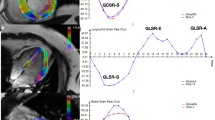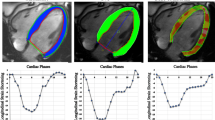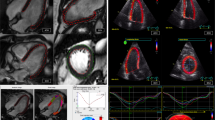Abstract
Background
Left ventricular strain may be a more sensitive marker of left ventricular dysfunction than ejection fraction in pediatric cancer survivors after anthracycline therapy, but there is limited validation of strain measurement by feature tracking on cardiovascular magnetic resonance (MR) images.
Objective
To compare left ventricular circumferential and radial strain by feature tracking vs. harmonic phase imaging analysis (HARP) in pediatric cancer survivors.
Materials and methods
Twenty-six patients (20.2 ± 5.6 years old) underwent cardiovascular MR at least 5 years after completing anthracycline therapy. Circumferential and radial strain were measured at the base, midventricle and apex from short-axis myocardial tagged images by HARP, and from steady-state free precession images by feature tracking.
Results
Left ventricular ejection fraction more closely correlated with global circumferential strain by feature tracking (r = −0.63, P = 0.0005) than by HARP (r = −0.39, P = 0.05). Midventricular circumferential strain did not significantly differ by feature tracking or HARP (−20.8 ± 3.4 vs. −19.5 ± 2.5, P = 0.07), with acceptable limits of agreement. Midventricular circumferential strain by feature tracking strongly correlated with global circumferential strain by feature tracking (r = 0.87, P < 0.0001). Radial strain by feature tracking had poor agreement with HARP, particularly at higher values of radial strain. Intraobserver and interobserver reproducibility was excellent for feature tracking circumferential strain, but reproducibility was poor for feature tracking radial strain.
Conclusion
Midventricular circumferential strain by feature tracking is a reliable and reproducible measure of myocardial deformation in patients status post anthracycline therapy, while radial strain measurements are unreliable. Further studies are necessary to evaluate potential relation to long-term outcomes.





Similar content being viewed by others
References
Shankar SM, Marina N, Hudson MM et al (2008) Monitoring for cardiovascular disease in survivors of childhood cancer: report from the Cardiovascular Disease Task Force of the Children’s Oncology Group. Pediatrics 121:e387–396
Mulrooney DA, Yeazel MW, Kawashima T et al (2009) Cardiac outcomes in a cohort of adult survivors of childhood and adolescent cancer: retrospective analysis of the Childhood Cancer Survivor Study cohort. Brit Med J 339:4606
(2008) Long-term follow-up guidelines for survivors of childhood, adolescent and young adult cancers, version 3.0. Children’s Oncology Group. http://www.survivorshipguidelines.org/. Accessed 20 March 2014
Armstrong GT, Plana JC, Zhang N et al (2012) Screening adult survivors of childhood cancer for cardiomyopathy: comparison of echocardiography and cardiac magnetic resonance imaging. J Clin Oncol 30:2876–2884
Ganame J, Claus P, Uyttebroeck A et al (2007) Myocardial dysfunction late after low-dose anthracycline treatment in asymptomatic pediatric patients. J Am Soc Echocardiogr 20:1351–1358
Toro-Salazar OH, Gillan E, O’Loughlin MT et al (2013) Occult cardiotoxicity in childhood cancer survivors exposed to anthracycline therapy. Circ Cardiovasc Imaging 6:873–880
Hoit BD (2011) Strain and strain rate echocardiography and coronary artery disease. Circ Cardiovasc Imaging 4:179–190
Hor KN, Gottliebson WM, Carson C et al (2010) Comparison of magnetic resonance feature tracking for strain calculation with harmonic phase imaging analysis. JACC Cardiovasc Imaging 3:144–151
Augustine D, Lewandowski AJ, Lazdam M et al (2013) Global and regional left ventricular myocardial deformation measures by magnetic resonance feature tracking in healthy volunteers: comparison with tagging and relevance of gender. J Cardiovasc Magn Reson 15:8
Weber OM, Higgins CB (2006) MR evaluation of cardiovascular physiology in congenital heart disease: flow and function. J Cardiovasc Magn Reson 8:607–617
Hor KN, Wansapura J, Markham LW et al (2009) Circumferential strain analysis identifies strata of cardiomyopathy in Duchenne muscular dystrophy: a cardiac magnetic resonance tagging study. J Am Coll Cardiol 53:1204–1210
Castillo E, Osman NF, Rosen BD et al (2005) Quantitative assessment of regional myocardial function with MR-tagging in a multi-center study: interobserver and intraobserver agreement of fast strain analysis with harmonic phase (HARP) MRI. J Cardiovasc Magn Reson 7:783–791
Bansal M, Cho GY, Chan J et al (2008) Feasibility and accuracy of different techniques of two-dimensional speckle based strain and validation with harmonic phase magnetic resonance imaging. J Am Soc Echocardiogr 21:1318–1325
Cho GY, Chan J, Leano R et al (2006) Comparison of two-dimensional speckle and tissue velocity based strain and validation with harmonic phase magnetic resonance imaging. Am J Cardiol 97:1661–1666
Llesuy SF, Milei J, Gonzalez Flecha BS et al (1990) Myocardial damage induced by doxorubicins: hydroperoxide-initiated chemiluminescence and morphology. Free Radic Biol Med 8:259–264
Yu W, Li SN, Chan GC et al (2013) Transmural strain and rotation gradient in survivors of childhood cancers. Eur Heart J Cardiovasc Imaging 14:175–182
Mor-Avi V, Lang RM, Badano LP et al (2011) Current and evolving echocardiographic techniques for the quantitative evaluation of cardiac mechanics: ASE/EAE consensus statement on methodology and indications endorsed by the Japanese Society of Echocardiography. J Am Soc Echocardiogr 24:277–313
Koopman LP, Slorach C, Manlhiot C et al (2011) Assessment of myocardial deformation in children using Digital Imaging and Communications in Medicine (DICOM) data and vendor independent speckle tracking software. J Am Soc Echocardiogr 24:37–44
Kempny A, Fernandez-Jimenez R, Orwat S et al (2012) Quantification of biventricular myocardial function using cardiac magnetic resonance feature tracking, endocardial border delineation and echocardiographic speckle tracking in patients with repaired tetralogy of fallot and healthy controls. J Cardiovasc Magn Reson 14:32
Kutty S, Rangamani S, Venkataraman J et al (2013) Reduced global longitudinal and radial strain with normal left ventricular ejection fraction late after effective repair of aortic coarctation: a CMR feature tracking study. Int J Cardiovasc Imaging 29:141–150
Jung B, Markl M, Foll D et al (2006) Investigating myocardial motion by MRI using tissue phase mapping. Eur J Cardiothorac Surg 29:S150–157
Neizel M, Lossnitzer D, Korosoglou G et al (2009) Strain-encoded (SENC) magnetic resonance imaging to evaluate regional heterogeneity of myocardial strain in healthy volunteers: comparison with conventional tagging. J Magn Reson Imaging 29:99–105
Aletras AH, Ding S, Balaban RS et al (1999) DENSE: displacement encoding with stimulated echoes in cardiac functional MRI. J Magn Reson 137:247–252
Morton G, Schuster A, Jogiya R et al (2012) Inter-study reproducibility of cardiovascular magnetic resonance myocardial feature tracking. J Cardiovasc Magn Reson 14:43
Poterucha JT, Kutty S, Lindquist RK et al (2012) Changes in left ventricular longitudinal strain with anthracycline chemotherapy in adolescents precede subsequent decreased left ventricular ejection fraction. J Am Soc Echocardiogr 25:733–740
Acknowledgment
This study was supported by the Cancer Director’s Research Fund, through the University of Michigan Comprehensive Cancer Center.
Conflicts of interest
None.
Author information
Authors and Affiliations
Corresponding author
Rights and permissions
About this article
Cite this article
Lu, J.C., Connelly, J.A., Zhao, L. et al. Strain measurement by cardiovascular magnetic resonance in pediatric cancer survivors: validation of feature tracking against harmonic phase imaging. Pediatr Radiol 44, 1070–1076 (2014). https://doi.org/10.1007/s00247-014-2992-2
Received:
Revised:
Accepted:
Published:
Issue Date:
DOI: https://doi.org/10.1007/s00247-014-2992-2




